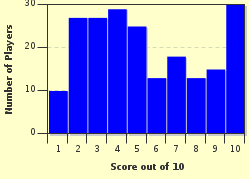Quiz Answer Key and Fun Facts
1. What class of matter is a solution?
2. Why will salt dissolve in water, but not oil?
3. Which of these solutions is capable of dissolving gold?
4. While on a camping trip, you shine your flashlight through a thick fog. Because of the fog, you can see the beam of light from your flashlight. Is fog a solution?
5. Which of these is a solution?
6. Which of these is a solution?
7. Which of these is not considered part of hydration when dissolving a substance in water? Solute is the substance dissolved, solvent is the substance dissolving the solute.
8. If a solution is supersaturated with a substance, what happens when I add a tiny crystal of the substance?
9. Which of these will lower the freezing point of water the most?
10. Two solutions are set up so that they are in the same beaker, but are separated by a membrane that only water can pass through. One solution contains 4% sugar while the other contains 5% sugar. How will the water levels of the solutions change if left undisturbed for three days?
Source: Author
jadeviper
This quiz was reviewed by FunTrivia editor
crisw before going online.
Any errors found in FunTrivia content are routinely corrected through our feedback system.


